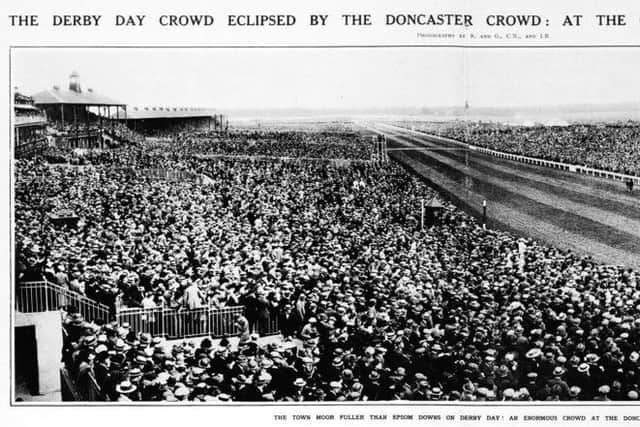How the St Leger brought horse racing's greats - and a little glamour - to Doncaster


HOW times change. Nearly a century ago, 500,000 racegoers made the pilgrimage to Doncaster’s Town Moor to celebrate the return of the St Leger horse race following the Great War. Fast forward 100 years and the highlight of this historic four-day festival will – for many – be the fun and frivolity of Ladies Day this afternoon (and evening), one of the highlights of the South Yorkshire social calendar.
Yet, while the crowds were certainly more deferential in the immediate aftermath the First World War when the popularity of the world’s oldest Classic, first staged in 1776, was at its peak – the Illustrated London News headlined its iconic photograph ‘The Derby Day crowd eclipsed by the Doncaster crowd: At the great race meeting in the North’ – both are emblematic of horse racing’s importance to the town and vice-versa.
Advertisement
Hide AdAdvertisement
Hide AdIndeed it is this colourful social history, synonymous with the fluctuating fortunes of the famous race, that has prompted local historian and retired teacher Tony Barber to produce a new book charting the St Leger’s significance. Visits to the racecourse in the early 1960s with his late grandfather Jack Kearns inspired a lifelong fascination with the race, this stamina-sapping mile three quarters mile long which still regarded as the ultimate test of the thoroughbred.


“My grandfather was a miner from Doncaster and took me to the St Leger as a young boy,” Edlington-born Mr Barber told The Yorkshire Post. “It was the big miner’s race. You went to the St Leger as a pilgrim, a crusade. I remember being completely overwhelmed by the extent of the crowds and the sheer spectacle – the sideshows, the escape artists in their Houdini suits and all the fun of the fair.
“It was, in many respects, still the last remnants of the Great Carnival of the North but things were changing in the 1960s. Society was changing. People were more affluent after the Second World War and going on holiday. There was also the licensing of the betting shops – the crowds on Leger day became 50-60,000 rather than 200,000 or 300,000 in the years after the Great War.
“The old tramps didn’t turn up because they were being looked after by the Welfare State for the first time; a lot of the colour went out of sporting crowds in this period. My grandfather and I would go in the Silver Ring on the inside of the course – we never went into the stands. I was just a boy from a mining village in awe of the surroundings.”
Advertisement
Hide AdAdvertisement
Hide AdOne of the author’s most cherished memories is of Lester Piggott and the brilliant Nijinsky winning the fabled Triple Crown in the 1970 when they added the St Leger to the 2000 Guineas and Epsom Derby. No colt has achieved in the feat in the subsequent 46 years, though Aidan O’Brien’s Camelot was narrowly denied in 2012 and Oh So Sharp, trained by the late Sir Henry Cecil, did win the fillies’ equivalent in 1985 under American wonderjockey Steve Cauthen.


“There was a tremendous sense of anticipation,” he said. “Prior to the race, Lester had fallen off a horse and there were rumours – unfounded – that he had been shot and that he would not be able to ride the great horse. Yet they put in a stupefying performance, the writer Quintin Gilbey observing ‘I am sure that in 50 years time those who were very young when they saw him humble the opposition in his successful quest for the Triple Crown will be telling their grandchildren of the exploits of the most beautiful horse that ever lived’. He was right.”
A born optimist despite his humble roots, Mr Barber is convinced the feat will be repeated in the future because top owner-breeders, like John Magnier who heads the world-famous Coolmore Stud in Ireland and who owned the aforementioned Camelot, has a profound sense of history.
He believes a resurgence in horses who are bred to stay will help to restore some prestige to the St Leger – this Saturday’s renewal, headed by odds-on favourite Idaho, does appear to lack some star-dust and the meeting also now clashes with the newly-formed Irish Champions Weekend. Horses, jockeys and trainers simply can’t be on both sides of the Irish Sea as the sport becomes more global.
Advertisement
Hide AdAdvertisement
Hide AdYet, while the abiding impression for many will be slightly tipsy female racegoers dispensing with their high heels, and swapping them for flip-flops, as they leave the racecourse, the St Leger meeting has – contrary to popular perception – long been a showcase for fashion. Mr Barber notes how the stands were packed with “glamour and opulence” in the late 1800s – this was the Royal Ascot of the North – while the stylish Princess Mary, the Kate Middleton fashion icon of her age, was another regular attendee.
Even the Queen graced Doncaster with her presence on several occasions after the Second World War – she was accompanied by Sir Winston Churchill in 1953 who became the first, and only, serving prime minister to attend the St Leger. However even those six-figure crowds were a fraction of those who turned Town Moor into a heaving mass of humanity immediately after the Great War to welcome an all-too-brief return to normality.
The context is important. Even though the Derby and Oaks, two of Flat racing’s iconic contests, retained their names when they were switched from Epsom to Newmarket during World War One, the then Doncaster Corporation decreed: “Whenever the St Leger is run, it will be at Doncaster.” That’s why the race was modestly called the September Stakes until the guns fell silent across Europe.
And this, says Mr Barber, explains the record crowds in, first 1919, and the 1920 when it is estimated that half a million people watched Caligula surge to victory as spectators, at least 50 deep in places, lined the entire home straight with characteristic good humour.
Advertisement
Hide AdAdvertisement
Hide Ad“After five years of hell, now it was a time for celebration,” he reflected. “The railway had been the making of Doncaster and the St Leger. There’s evidence to suggest that people turned out because they had more money.
“Within a year, that sense of optimism disppeared. To begin with, during the 12 months after the St Leger of 1920, major strikes involving railway workers and coal miners hit the country. For a number of reasons, Doncaster suffered particularly badly. Whereas in the early days of the St Leger the town had dependent on agriculture for its wellbeing, it had become heavily industrialised. During the period of the Great Depression and General Strike, things did not readily improve.”
As for this year’s St Leger, up to 30,000 spectators are expected on Town Moor – a fraction of the crowd. Yet some traditions remain – like the cap awarded to the winning jockey or how the first baby born in Doncaster on the day of the race is given free membership to the course on their 18th birthday.
No other race, with the possibility of the Grand National, has this bond with its townspeople. And, because of this, Tony Barber says the St Leger will always be an unique occasion like no other.
Advertisement
Hide AdAdvertisement
Hide AdThe St Leger: A history of the world’s first Classic horserace by Tony Barber is a signed limited edition of 800 copies priced £75. Copies can be ordered via the Racing Post website at www.racingpost.com/shop